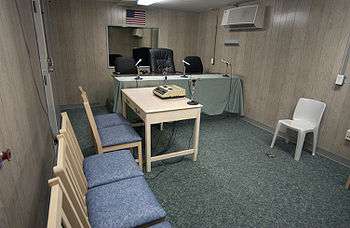Muhammad al-Ansi
| Muhammad Ahmad Abdallah Al Ansi | |
|---|---|
 | |
| Detained at | Guantanamo |
| ISN | 29 |
| Charge(s) | No charge, held in extrajudicial detention |
Muhammad Ahmad Abdallah Al Ansi is a citizen of Yemen, held in extrajudicial detention in the United States Guantanamo Bay detention camps, in Cuba.[1] Al Ansi's Guantanamo Internee Security Number is 029. American intelligence analysts estimate that Al Ansi was born in 1975, in Sanaa, Yemen.
He was cleared for release on December 9, 2016, a recommendation made public on December 22.[2] He was transferred to Oman with nine other men, on January 16, 2017.[3][4][5]
Official status reviews
Originally the Bush Presidency asserted that captives apprehended in the "war on terror" were not covered by the Geneva Conventions, and could be held indefinitely, without charge, and without an open and transparent review of the justifications for their detention.[6] In 2004 the United States Supreme Court ruled, in Rasul v. Bush, that Guantanamo captives were entitled to being informed of the allegations justifying their detention, and were entitled to try to refute them.
Office for the Administrative Review of Detained Enemy Combatants

Following the Supreme Court's ruling the Department of Defense set up the Office for the Administrative Review of Detained Enemy Combatants.[6][9]
Scholars at the Brookings Institution, lead by Benjamin Wittes, listed the captives still held in Guantanamo in December 2008, according to whether their detention was justified by certain common allegations:[10]
- Muhammad Ahmad Abdallah Al Ansi was listed as one of the captives who "The military alleges ... are associated with both Al Qaeda and the Taliban."[10]
- Muhammad Ahmad Abdallah Al Ansi was listed as one of the captives who "The military alleges ... traveled to Afghanistan for jihad."[10]
- Muhammad Ahmad Abdallah Al Ansi was listed as one of the captives who "The military alleges ... took military or terrorist training in Afghanistan."[10]
- Muhammad Ahmad Abdallah Al Ansi was listed as one of the captives who "The military alleges ... were at Tora Bora."[10]
- Muhammad Ahmad Abdallah Al Ansi was listed as one of the captives who "The military alleges ... served on Osama Bin Laden's security detail."[10]
- Muhammad Ahmad Abdallah Al Ansi was listed as one of the captives who was an "al Qaeda operative".[10]
- Muhammad Ahmad Abdallah Al Ansi was listed as one of the captives who had "denied all the government allegations."[10]
Al Ansi chose to participate in his Combatant Status Review Tribunal.[11]
Shortly after his Tribunal procedures were explained to him Al Ansi expressed concern over how long the Tribunal would last, and asked to leave.
The Tribunal reconvened after he had been removed long enough for the Tribunal's President to review Al Ansi's election form, which recorded that he had originally wanted to attend his Tribunal.
Al Ansi chose to participate in his Administrative Review Board hearing.[12]
Al Ansi requested a copy of the proceedings of his Tribunal.[12] He told his Board that he had requested it five days prior to his Board. He told his Board that other detainees had been given copies of their Tribunals. Al Ansi's Board went into closed session to consider his request. When they reconvened in open session Al Ansi was told that he would not get access to his Tribunal record because it was classified.
Writ of Habeas Corpus
Al Ansi had a writ of habeas corpus, Civil Action No. 08-cv-1923, filed on his behalf.[13]
The Military Commissions Act of 2006 mandated that Guantanamo captives were no longer entitled to access the US civil justice system, so all outstanding habeas corpus petitions were stayed.[14]
On 12 June 2008 the United States Supreme Court ruled, in Boumediene v. Bush, that the Military Commissions Act could not remove the right for Guantanamo captives to access the U.S. Federal Court system. And all previous Guantanamo captives' habeas petitions were eligible to be re-instated. The judges considering the captives' habeas petitions would be considering whether the evidence used to compile the allegations the men and boys were enemy combatants justified a classification of "enemy combatant".[15]
Al-Ansi's petition was filed after the Supreme Court's ruling in Boumediene v. Bush.[13]
In late December 2008 the United States Department of Justice proposed amalgamating fifteen separate petitions, including Al-Ansi's, because they claimed those captives were all captured in Tora Bora.[13]
On December 30, 2008 United States Department of Justice official Daniel M. Barish informed the court that the DoJ had filed "factual returns" in seven habeas cases, including Al-Ansi's.[16]
Formerly secret Joint Task Force Guantanamo assessment
On April 25, 2011, whistleblower organization WikiLeaks published formerly secret assessments drafted by Joint Task Force Guantanamo analysts.[17][18] His 10-page Joint Task Force Guantanamo assessment was drafted on May 17, 2008.[19] It was signed by camp commandant Rear Admiral David M. Thomas Jr. He recommended continued detention.
Guantanamo Joint Review Task Force
In April 2015 Jason Leopold succeeded in getting access to the list of 71 individuals who were not cleared for release, and not recommended for holding for trial, who were determined to be eligible for Periodic Review Board hearings.[20] Al Ansi was one of the individuals the task force recommended should face indefinite detention, without charge.
References
- ↑ "List of Individuals Detained by the Department of Defense at Guantanamo Bay, Cuba from January 2002 through May 15, 2006" (PDF). United States Department of Defense. Retrieved 2006-05-15.
- ↑
Carol Rosenberg (2016-12-22). "Guantanamo board clears bin Laden bodyguard". North Carolina Courier Tribune. Retrieved 2016-12-23.
But as the Obama administration was trying to put the finishing touches on proposed Guantanamo transfers before President-elect Donald Trump takes office, the Periodic Review Board disclosed that it approved al-Ansi's release on Dec. 9.
- ↑
Greg Myre (2017-01-16). "10 Guantanamo Prisoners Freed In Oman; 45 Detainees Remain". National Public Radio. Retrieved 2017-01-17.
The freed prisoners were not identified by name or nationality, though the Oman News Agency, citing the country's Foreign Ministry, reported that the 10 had arrived in the country on Monday for "temporary residence."
- ↑
Carol Rosenberg (2017-01-16). "U.S. sends 10 Guantánamo captives to Oman". Miami Herald. Archived from the original on 2017-01-17.
A Pentagon official who spoke on condition of anonymity confirmed that the transfer had taken place, downsizing the detainee population to 45. Neither Oman nor the official provided the identities of the 10 men who were sent there.
- ↑
Carol Rosenberg (2017-01-16). "Victims of mistaken identity among the 10 sent from Guantánamo to Oman". Miami Herald. Archived from the original on 2017-01-18.
A Pentagon statement did not explain why the Department of Defense chose to wait to identify the 10 men for more than a day after the Sultanate of Oman announced it had taken them in as "temporary" residents "in consideration to their humanitarian situation."
- 1 2
"U.S. military reviews 'enemy combatant' use". USA Today. 2007-10-11. Archived from the original on 2012-08-11.
Critics called it an overdue acknowledgment that the so-called Combatant Status Review Tribunals are unfairly geared toward labeling detainees the enemy, even when they pose little danger. Simply redoing the tribunals won't fix the problem, they said, because the system still allows coerced evidence and denies detainees legal representation.
- ↑ Guantánamo Prisoners Getting Their Day, but Hardly in Court, New York Times, November 11, 2004 - mirror Archived 2007-09-30 at the Wayback Machine.
- ↑ Inside the Guantánamo Bay hearings: Barbarian "Justice" dispensed by KGB-style "military tribunals", Financial Times, December 11, 2004
- ↑ "Q&A: What next for Guantanamo prisoners?". BBC News. 2002-01-21. Archived from the original on 24 November 2008. Retrieved 2008-11-24.
- 1 2 3 4 5 6 7 8 Benjamin Wittes, Zaathira Wyne (2008-12-16). "The Current Detainee Population of Guantánamo: An Empirical Study". The Brookings Institution. Archived from the original (PDF) on 2012-06-22. Retrieved 2010-02-16.
- ↑ "Summarized Detainee Statement" (PDF). OARDEC. 2004. Archived from the original (PDF) on 2006-07-31. Retrieved 2016-12-23.
- 1 2 "Summary of Administrative Review Board Proceedings for ISN 029" (PDF). OARDEC. 2005. Archived from the original (PDF) on 2006-07-31. Retrieved 2016-12-23.
- 1 2 3 Jennifer Cowan (2009-01-08). "Guantanamo Bay Detainee Litigation: Doc 1490 -- Petitioner's Submissions For The January 5, 2008 Joint Filing In Response To The Court's December 17, 2008 Order" (PDF). United States Department of Justice. Retrieved 2009-01-12.
- ↑ Peter D. Keisler, Douglas N. Letter (2006-10-16). "NOTICE OF MILITARY COMMISSIONS ACT OF 2006". United States Department of Justice. Archived from the original on 2008-09-30. Retrieved 2008-09-30.
- ↑ Farah Stockman (2008-10-24). "Lawyers debate 'enemy combatant'". Boston Globe. Archived from the original on 2008-10-24. Retrieved 2008-10-24.
- ↑ Daniel M. Barish (2008-12-30). "Guantanamo Bay Detainee Litigation: Doc 1430 -- NOTICE OF FILING OF FACTUAL RETURN" (PDF). United States Department of Justice. Retrieved 2009-01-12.
- ↑
Christopher Hope; Robert Winnett; Holly Watt; Heidi Blake (2011-04-27). "WikiLeaks: Guantanamo Bay terrorist secrets revealed -- Guantanamo Bay has been used to incarcerate dozens of terrorists who have admitted plotting terrifying attacks against the West – while imprisoning more than 150 totally innocent people, top-secret files disclose". The Telegraph (UK). Archived from the original on 2012-07-13. Retrieved 2012-07-13.
The Daily Telegraph, along with other newspapers including The Washington Post, today exposes America's own analysis of almost ten years of controversial interrogations on the world's most dangerous terrorists. This newspaper has been shown thousands of pages of top-secret files obtained by the WikiLeaks website.
- ↑ "WikiLeaks: The Guantánamo files database". The Telegraph (UK). 2011-04-27. Archived from the original on 2015-06-26. Retrieved 2012-07-10.
- ↑ "Muhammad Ahmad Abdallah Al Ansi: Guantanamo Bay detainee file on Muhammad Ahmad Abdallah Al Ansi, US9YM-000029DP, passed to the Telegraph by Wikileaks". The Telegraph (UK). 2011-04-27. Retrieved 2016-07-09.
- ↑ "71 Guantanamo Detainees Determined Eligible to Receive a Periodic Review Board as of April 19, 2013". Guantanamo Joint Review Task Force. 2013-04-19. Archived from the original on 2015-05-19. Retrieved 2017-01-19.